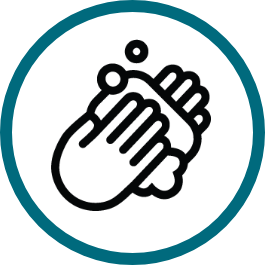Handwashing with soap could decrease diarrheal diseases and pneumonia among children under five by more than 50%.1The effect of handwashing on child health: A randomized controlled trial.
The Lancet, 366(9481): 225-33.
Luby, S. et al.
2004 This is a habitual behavior that must be practiced multiple times a day.

Handwashing with Soap
Family members wash hands with soap under running water at 4 critical times [after defecation, after changing diapers, before food preparation and before eating]
Key Points from Global Research
- Enabling construction and use of household handwashing stations can improve access to water and soap for household members.
- Using emotional messages can motivate individuals to wash their hands more readily than using messages focused on disease transmission.
- Visual cues can provide helpful reminders for habitual behaviors like handwashing and can increase the visibility of handwashing behaviors in communities.
Behavior Profile Sample: Handwashing with Soap
A Behavior Profile is a summary analysis of each behavior. This sample draws from global evidence and illustrates the result of using the Create Behavior Profiles Tool to analyze factors, supporting actors and strategies and to ensure logical pathways exist between strategies proposed and factors related to the practice of the behavior. This sample may be used as a starting point or reference for creating Behavior Profiles.
| Improve maternal and child survival | |
|
Family members wash hands with soap under running water at 4 critical times [after defecation, after changing diapers, before food preparation and before eating] Indicator: Among households where place for handwashing was observed, percentage of households with soap and water. Soap includes soap or detergent in bar, liquid, powder or paste form.
|
Behavior Analysis |
Strategy | ||
|---|---|---|---|
STEPSWhat steps are needed to practice this behavior?
Click on any box |
FACTORSWhat factors may prevent or support practice of this behavior? These should be analyzed for each country context.StructuralAccessibility: Family members are unable to wash their hands because they lack water and secured soap SocialFamily and Community Support: Family members do not wash their hands with soap because family members often do not reinforce handwashing, especially among younger children Norms: Family members do not wash their hands at all critical times because it is not regularly practiced or reinforced by community members InternalAttitudes and Beliefs: Family members wash their hands because they believe it is disgusting to not wash hands after defecation or before handling food Attitudes and Beliefs: Family members wash their children’s hands because they view it as a form of nurturing for children Knowledge: Family members do not always wash their hands because many are unaware of the diseases transmitted by unclean hands Knowledge: Family members do not always wash their hands at the critical moments because they forget |
SUPPORTING ACTORS AND ACTIONSWho must support the practice of this behavior?InstitutionalPolicymakers: Establish financing schemes for soap and handwashing stations CommunityCommunity Leaders: Support local soap and handwashing station marketing efforts Community Leaders: Promote hand washing at community events and public locations like schools, maintain a handwashing station in own household, and find ways to create reminders for handwashing at home or in the community HouseholdFamily Members: Encourage and assist children to wash their hands as a way of avoiding ingestion of feces |
POSSIBLE PROGRAM STRATEGIESHow might we focus our efforts based on this analysis?Enabling EnvironmentPolicies and Governance: Monitor and ensure availability of low-cost soap and handwashing stations for the most vulnerable Systems, Products and ServicesProducts and Technology: Develop locally appropriate handwashing stations and train families how to construct stations themselves Products and Technology: Integrate soap storage into handwashing station designs that reduce the risk of spoilage or theft of the soap Quality Improvement: Train providers to promote handwashing with caregivers Demand and UseAdvocacy : Support community leaders with tools to make handwashing behavior public, including installation of HW stations in public locations and publicly tracking the behavior Communication: Use media channels to highlight the risks of not washing hands with soap and promote the benefits of handwashing with soap behaviors (not washing hands after defecation and before eating means eating feces) Communication: Create context disruptions and visual cues in the community and household to provide reminders for handwashing |
Global Status of Accelerator Behavior
Indicator: Among households where place for handwashing was observed, percentage of households with soap and water. Soap includes soap or detergent in bar, liquid, powder or paste form.
The DHS Program Indicator Data API, The Demographic and Health Surveys (DHS) Program


 The Manoff Group was acquired by JSI in 2022.
The Manoff Group was acquired by JSI in 2022.